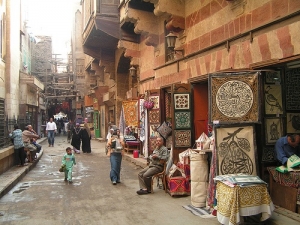The houses in the Street were built mainly in the mid-seventeenth century by Ridwan Bey al Faqari (who died in 1656), who held the title ‘Amir al-Hajj’, and the shops and ateliers were intended to provide Hajj pilgrims going to Mecca with everything they needed, including leather saddles and water bags, ropes, and, of course, tents. By the nineteenth century the craftsmen were also making and decorating urban pavilions used for family and official gatherings (rather than simply as living accommodation). Normally the outsides of these tents were made of plain, off-white cotton, while the insides were lined with intricate geometric patterns, often in blues, greens, red and yellows.
By the twentieth century fewer and fewer pavilions were being made and the craftsmen began to make wall hangings, smaller panels, cushion covers, bags and items of clothing. At the beginning of the twenty-first century a wider range of colours and designs had been developed in order to suit modern tastes. The main forms are:
1. Geometric or Islamic: this category includes traditional geometric designs for locally used tents and the like. These are regarded by many as the traditional form and represent the style most commonly copied in machine printed versions.
2. Calligraphic: appliqués based on traditional Islamic texts, especially those from the Qur’an. This type of design is in the same tradition as the medieval tiraz inscriptions. Basically these large panels are made for wall hangings decorating mosques and public buildings and for use as flags.
3. Pharaonic scenes: since the latter half of the nineteenth century panels have been made depicting scenes based on ancient Egyptian tomb and temple reliefs, modified versions of ancient hieroglyphs etc. In addition, designs depicting scenes of daily life in ancient Egypt, notably farmers, hunters, agricultural scenes and animals have been made. The production of this style is closely related to the opening of the Suez Canal in 1869, and the development of mass tourism (mostly from Europe and North America). At the end of the twentieth century, panels with birds, butterflies and fishes also became available.
4. Egyptian folklore and daily life: designs depicting daily life in ‘modern’ Egypt, notably agricultural, street and village scenes, dervishes, ships etc. By the end of the twentieth century, subjects such as Goha (a character in Egyptian folk literature) started to appear. This form of decoration is closely linked to the Wissa Wassef principles.
The Street is now catering for a local, national and an international tourist market, the latter not only including Westerners, but also buyers from other parts of the Arab world, as well as tourists from Asia, notably Chinese, Indians, Japanese and Koreans.
In the first half of 2015, the Textile Research Centre in Leiden mounted a special exhibition of appliqués from the Street of the Tentmakers.
The TRC has made a digital exhibition (dated 2017) featuring and describing the relevant objects in the TRC collection. To view the exhibition, click here.
Sources:
- DOEL, Joyce (1986). ‘Egyptian appliqué,’ Embroidery Magazine, Summer 37 (2), 62-63.
- FEENEY, John (1986). ‘Tentmakers of Cairo,’ Saudi Aramco World, November/December, pp. 16-25.
- SPRING, Christopher and Julie HUDSON (1995). North African Textiles, London: British Museum Press.
Digital source of illustration (retrieved 8th July 2016).
GVE

